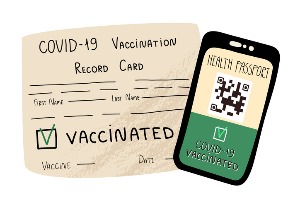
As the workforce continues to evolve and nonprofit employers struggle to find (and retain) top talent, leaders must prioritize employee engagement strategies and include development initiatives. To help nonprofit leaders rethink the employee experience, we’ve compiled our top resources to create the 2022 Employee Engagement Toolkit.
With all that you do for the communities you serve, it’s critical that you focus on those who keep your mission moving forward by fostering a work culture where employees feel valued, involved and supported—keeping them intrinsically motivated and engaged. Download the free toolkit and gain access to all of these resources:
To access more HR-specific articles, templates and checklists, you can sign up for a FREE 60-Day Trial of UST HR Workplace today! You’ll also gain access to live HR certified consultants, 300+ on-demand training courses, and a virtual compliance library.

Employee benefits, also known as perks and fringe benefits, are provided to employees over and above salaries and wages. Employee benefit packages may include overtime, medical, dental, vacation, profit sharing and retirement benefits, to name just a few. Offering these types of benefits to your employees is important because it shows them you are invested in not only their overall health, but their future. A rich employee benefits package can help attract and retain talent. Benefits also have the ability to help set you apart from competing organizations—benefits more often than not, can be the deciding factor when future talent decides to accept a job offer.
When looking at fringe benefits, there are two types, fringe benefits that are required by law (i.e., social security and health insurance and fringe benefits provided at the organization’s discretion. (i.e. free breakfast and lunch, gym membership, employee sock options, retirement planning services, child care, education assistance, etc.). Organizations will offer additional fringe benefits in hopes of increasing employee wellness and employee engagement. Employees often work harder when they feel their employer appreciates their contribution to the organization. One way to increase employee satisfaction is by providing additional benefits like paid holidays, employer-provided car, workplace flexibility, etc. It will help reduce incidences of a disgruntled workforce and keep the employees engaged.
Healthcare and retirement benefits are important for obvious reasons, but the popularity of additional fringe benefits seem to be on the rise, especially following a global pandemic. Check out UST’s list of Creative Workplace Benefits for some ideas on how you as an employer, can show your staff support while increasing your chances of retaining your employees.
Being creative with your benefits package at a budget restricted nonprofit can be less expensive and often better received than a raise, so put on your thinking cap and leave no stone unturned. Remember, money alone will not keep employees engaged so take the time to come up with a plan to show them some appreciation.

The grantmaking process is often exclusive and expensive, making it accessible to those select nonprofits with the right expertise and networks, which can be costly for organizations and funders to seek and distribute funding. Applying for grants is a tedious and expensive process, with a good percentage of applications taking upwards to a week or more just to write. To help those communities who’ve been commonly excluded to thrive, organizations with access to capital need to start adopting more equitable grantmaking practices—making funding more accessible to everyone. Grantmakers have a responsibility to create equitable processes, making sure that communities of color and other marginalized populations are not adversely impacted by giving practices.
When looking at grantmaking, diversity includes casting a wide net to attract diverse applicants. Inclusion might mean your reviewers are diverse, mirroring the community the organization serves. Equity might include revamping the application process making it more accessible.
In following these four tips, nonprofit organizations will be more equipped to have the right processes in place to evaluate equitable grantmaking:
1) Create a More Diverse Pool of Applicants: The first step toward equitable grantmaking is to encourage a diverse applicant pool. If nonprofits serving marginalized communities don’t know about your funding, they won’t be able to apply. Examine your pipeline to determine if you’re casting a wide net outside of your familiar go-to organizations. Look into expanding your networks—we all have a tendency to build relationships with those like ourselves. Attend diverse community meetings, events, or town halls to promote your fund.
2) Keep the Entire Application Process Simple: Grant applications can feel complicated to newer applicants. Use clear, simple language when creating instructions and applications. The general rule is to write at an eighth-grade reading level. (Word offers this functionality–you can use google to find out how to use it). When it comes to equitable grantmaking, ADA-friendly applications are a must. For example, screen reader capability and keyboard accessibility create an equitable website experience. Without these, applicants with disabilities may have difficulty applying.
3) Lower Chances of Bias in Review Process: Implicit bias is an unconscious association made about social groups. For example, many automatically assume business executives are male and secretaries are female. While it is ingrained in us from a young age, implicit bias can hinder best intentions for equitable grantmaking. By creating an unbiased review process, you’ll strengthen the entirety of the grant review process. Some examples include, offer implicit bias training to your reviewers and examine reasons why applicants were rejected.
4) Review Reporting Metrics: Metrics are vital to any funder’s success—including equitable giving outcomes. Be sure to create equity metrics early in the process. You’ll want to track data points such as the number of diverse applicants and awardees.
To reduce funding barriers, make sure to take a closer look at your processes from beginning to end. Take a look at each step and try to pin-point when diverse populations are no longer in the forefront. Be open to outside perspectives who could provide unique solutions—grantees and reviewers could offer ideas around inclusivity and/or equity.

Question: Can we share employee vaccination status with managers so they can enforce any policies based on that information, such as masking and social distancing?
Answer: Yes. Obviously, managers will need this information if they are expected to enforce vaccination-dependent policies, and employers should train them on how they should be enforcing the policies and how and when to escalate issues to HR or a higher level of management. However, you should not share this information any more widely than necessary. Vaccination status is medical information that must be kept confidential.
While anonymized information is okay to share widely—e.g., “80% of our employees are vaccinated!”—each employee’s vaccination status should be treated as confidential, even if the fact that they are wearing a mask to work seems to reveal their status publicly.
Q&A provided by Mineral, powering the UST HR Workplace. Have HR questions? Sign your nonprofit up for a FREE 60-day trial here. As a UST member, simply log into your Mineralportal to access live HR certified consultants, 300+ on-demand training courses, an extensive compliance library, and more.

Today’s increasingly virtual landscape—along with the workforce’s evolving strategic priorities—has not only changed how we work, but it’s also impacted the way we interact with one another. Employee engagement practices are an essential part of any organization—they can save the company money, improve productivity, increase morale, and decrease turnover. To maintain positive morale and strengthen company culture, nonprofit leaders must prioritize employee engagement and brand reputation strategies.
For just $29 you can discover helpful tactics for building a strong nonprofit brand while fostering an engaged workforce. During this on-demand webinar, you’ll learn:
Register today and you’ll also receive essential handouts for nonprofit leaders—including an employee engagement checklist, a comprehensive onboarding plan as well as creative ideas for celebrating your team and more—FREE with your registration.

Members are a vital key to success when sustaining and growing your association and retaining those members ensures a long-term survival of your nonprofit organization. While recruiting and enrolling new members is important for growth, making a conscience effort to retain members is equally as important. Making your current members feel important and special, reminds them of why they joined your association in the first place. Some tried and true retention methods include creating specialized resources, and educational content—the more you publish industry reports, educational webinars, or offer member discounts, the happier your members will be.
The best course of action to take when retaining members include, focusing on their needs, remind them how much value they bring to your association and engaging them on a regular basis. We’ve put together a list of 5 best practices for improving member retention at your nonprofit organization:
1) Create an Onboarding Plan: First-time members are a specific group within your membership profile that need to be approached with specific strategies. Look for ways to keep new members engaged—monthly check-ins, education materials about new products, keep them informed about upcoming events like webinars or virtual conferences—give them opportunities to learn more about the work your organization is doing in the nonprofit sector.
2) Offering Member Only Benefits: Members are interested and/or passionate about your cause, and they want to feel like they’re making a difference. Communicate with them often with weekly or monthly newsletters as well as through social media. Provide perks such as exclusive, member-only offers from your partners as well as networking opportunities. If possible, provide educational opportunities such as webinars, workshops, and relevant eBooks at member-only prices.
3) Create a Community for Your Members: Encourage a thriving, engaged community of like-minded individuals. Such as, organizing/hosting more networking events, mentorship programs, and creating an online member directory—all methods that can help to increase member retention.
4) Remind Members of the Value You Offer: In your end-of-year communications to members, remind them how their membership with your organization has benefited their association over the past year and how much value their membership brings to your organization.
5) Ask Members to Complete an Exit Survey: While it’s not ideal, it is the reality that there will be members who will choose to cancel their membership. This is a great opportunity to capture unique insight into why a member is leaving by asking them to fill out an exit survey. The data acquired can bring light to pitfalls or areas of your organization to be reviewed and improved upon.
Member retention isn’t just a one-time activity. It is something that’s kept in mind throughout the whole member lifecycle—it’s a strategy that requires just as much attention as recruiting new members. To keep members around long-term, you should be focusing on building better relationships with your members from day one.

Question: HR Compliance: What It Is and Why It’s So Complicated
Answer: Running a business comes with no shortage of perks. You get the freedom to be your own boss, invest in an idea, steer its trajectory, and create wealth. It has its challenges, too. Competition may be fierce. Demand for what you offer may be low. Costs may not be sustainable. But even if everything else is going your way, there’s one challenge that’s ever-present. We’re talking, of course, about HR compliance.
The Definition of HR Compliance
HR compliance is the work of ensuring that your employment practices conform to federal, state, and local laws. This work requires learning which laws apply to your organization and understanding what they require you to do. That’s easier said than done.
HR compliance is truly an art. It requires knowledge, skill, and cooperation. You have to be able to decipher legalese, know where to go to ask the right questions, and create policies and procedures that minimize business risk. You have to ensure that everyone from the executive team to newly minted managers know what they can and cannot do. You have to conduct investigations and enforce your rules consistently. And all this is just the bare minimum—necessary, but not enough to create a truly successful culture.
The work of compliance is never entirely done. Not only do new legal requirements appear on the regular, but, as you’ll read below, compliance obligations are often unclear. While some compliance obligations are definitive, others are unresolved, and a good number require you to make a judgment call. Let’s look at each of these in turn.
Why HR Compliance Can’t Always Be Assured
Some employment laws take the form of “Do this” or “Don’t do that.” The requirements may be simple, like minimum wage, or complex, like FMLA, but either way there’s usually no real question about what you need to do or not do. Compliance with these laws is pretty straightforward. Don’t pay less than the minimum wage. Provide leave to eligible employees for the reasons that qualify, continue their health benefits (if applicable), and return them to their position when their leave ends. As long as you’re clear on the details, you’re not likely to lose sleep wondering if you’re compliant.
Sometimes, however, those details are unsettled. Lawmakers don’t always specify everything a law requires before it passes or takes effect. Even when laws seem clear, trying to put them into practice often raises a lot of questions. And the legislature isn’t the only source of law: regulatory agencies demand their say, and courts get involved, too. To complicate matters, these branches of government don’t always agree with each other, and what they say today may not be what they say tomorrow. Keeping up with the latest official guidance takes time and persistence. It can feel like a marathon, when what you want is a quick sprint to the answer. You have other demands on your time, after all.
Finally, a lot of employment laws have standards you have to follow, but they don’t tell you how. Neither the IRS nor the DOL, for example, tells you whether your workers are employees or independent contractors—unless there’s an audit or complaint. Instead, these agencies publish tests with general criteria that you use to make case-by-case determinations.
The Americans with Disabilities Act (ADA) works this way, too. The ADA requires employers to provide reasonable accommodations to employees with disabilities, with a few exceptions. One of the exceptions is that the accommodation doesn’t create an undue hardship on the employer’s business. The basic definition of an undue hardship is an action that creates a significant difficulty or expense. Although the law provides factors to consider in making this determination, the onus is on you to decide whether an expense or difficulty from an accommodation is significant. And, ultimately, your conclusion could be challenged in court.
Why HR Compliance Looks Like This
If HR compliance seems overly-complicated, that’s because it is. Our current legal landscape is the result of three competing philosophies about how the workplace should be governed, who should govern it, and whose rights in the workplace should be prioritized in the law.
Owner Control
According to the first view, business owners should have control over their workplaces for one simple reason. They own the business. It’s their property, and as owners they should have the legal right to govern it. Employees have no right to control aspects of the workplace because the workplace isn’t theirs. They don’t own it. It’s not their property. If they don’t like the terms and conditions of their employment, they can and should go elsewhere.
While an owner might employ managers or an executive team to make decisions about who to hire and fire, what to pay, how to assign work, and other such matters, the owner remains in charge. Advocates of this view include the economist Milton Friedman. In 1970, he famously argued that corporate executives should bow to the desires of the owners. The will of the owners reigns supreme.
Worker Control
According to the second view, workers should have a say in the decisions that get made simply because those decisions affect them and their livelihoods. In this line of thinking, the governance of the workplace should adhere to the principles of democracy. However, proponents for this view differ on how democracy in the workplace should be practiced.
In the 1930s, Senator Robert F. Wagner introduced the National Labor Relations Act. He wanted to guarantee the “freedom of action of the worker” and ensure that workers were “free in the economic as well as the political field.” Today, talk of democratizing the workplace usually refers to bolstering unions. But there are other proposals to note. Some champions of workplace democracy, like Senator Elizabeth Warren, have pushed for employee representation on corporate boards. Others favor cooperative models in which the division between employers and employees doesn’t exist.
Full-fledged workplace democracy is still a fringe view, though. The very definition of an employee remains a worker who does not have the right to control what the work is, how it’s done, or how it’s compensated. Employees may be given authority to make decisions. They may have influence over their superiors. But they are not legally in charge.
Societal Control
Advocates of the third view argue that the government has an interest in exercising some measure of control over the work and the workplace. In the employer-employee relationship, employers typically have significantly more power than employees—especially an employee acting as an individual. Frances Perkins, who served as Secretary of Labor and was a key architect of the New Deal, believed that government “should aim to give all the people under its jurisdiction the best possible life.” She saw a role for legislatures in countering long hours, low wages, and other conditions unfavorable to employees.
How These Philosophies Have Played Out
In the United States, HR compliance is the result of these three competing and arguably incompatible philosophies. Government action with respect to employment has tried to empower workers and afford them certain rights, protections, and freedoms in the workplace, all while preserving the employer’s control over their business.
We can see this balancing act in the differences among state laws. Some states prioritize the right of owners to control their workforces and are loath to restrict that right through legislation. Other states act out of what they see as a duty to secure the rights of workers. Imposing obligations on employers doesn’t bother them.
We also see this balancing act in the way that employment laws tend to set parameters rather than dictate exactly what employers must do. You can pay employees whatever you want, so long as you pay at least the minimum, offer an overtime premium when applicable, and meet equal pay requirements. You can theoretically terminate employment for any reason or no reason at all (though we don’t recommend it); but you can’t fire someone for an illegal reason. Even laws that require a new practice, such as paid leave, allow flexibility provided you meet minimum conditions.
Takeaways
First, when you’re assessing your compliance obligations, understand that not all compliance obligations are clearly delineated or settled law. Unsettling as that may be, it’s how our system has been set up. In those cases, you’ll have to weigh your options and the risks involved, and then make a decision. Sometimes you may need legal advice in addition to HR guidance. Remember, however, that despite all the many employment laws on the books and in the imaginations of legislators, the system is designed to keep employers in charge. You can’t eliminate all risk, but by understanding the nuances and open questions, you can significantly minimize it.
Second, document your actions and decisions. It only takes an employee filing a complaint for enforcement agencies to get involved, but you are better protected if you can quickly and clearly explain to them the reason for your actions.
Third, evaluate whether your policies, procedures, and practices are satisfactory to employees. No employment law gets written in a vacuum, and no law is truly inevitable. Lawmakers passed the Fair Labor Standards Act because workers and the general public felt that labor standards were unfair. Today we wouldn’t have people pushing for predictive scheduling laws if they felt that work schedules were already sufficiently predictable. Harassment prevention training wouldn’t be mandatory (where it is) if sexual harassment weren’t widespread.
Fourth, lead by example. Make good employee relations a key part of your brand and competitive advantage. Employees have higher expectations today than they used to. Meet those expectations and motivate other employers to do the same, and you may find that the compliance landscape of the future is less winding and boggy than it could have been.
Finally, spend some time each day learning about your compliance obligations. Use resources that break down federal and state employment laws in a way that laypeople can understand. Keep up to speed on the latest compliance obligations and contingencies you should consider. HR compliance is an art. The first step to mastering it is learning what it entails and how it works.
You can also download the Telecommuting Checklist as a tool for when an employee is transitioning to a remote schedule. Q&A provided by Mineral, powering the UST HR Workplace. Have HR questions? Sign your nonprofit up for a FREE 60-day trial here. As a UST member, simply log into your Mineral portal to access live HR certified consultants, 300+ on-demand training courses, an extensive compliance library, and more.

Nonprofit managers are relied upon to not only lead productive teams, hold employees accountable, and manage processes but are also expected to engage and motivate employees with limited funding. They must be innovative, resourceful, and strategic. To help nonprofit leaders maintain high-performing teams—while also strengthening their leadership skills—we created the 2021 Nonprofit Leadership Toolkit.
This free toolkit includes a performance appraisal checklist, manager-employee check-in form, tips for leading a hybrid workforce, and more:
Want access to more HR-specific articles, templates and checklists? Sign up for a FREE 60-Day Trial of UST HR Workplace today! You’ll also gain access to live HR certified consultants, 300+ on-demand training courses and an extensive compliance library.

Whether you’re aspiring to be an executive leader, get promoted into a director’s position, or even launch your own nonprofit—rarely there are clearly defined paths to career development when working in the nonprofit sector. While this lack of structure can be challenging, it offers an unexpected opportunity to pave or create your own career path. Without the typical career ladder to climb, the opportunity to take on new responsibilities could be presented to you in a more timely fashion. At any age, with drive, desire and expertise being essential characteristics, you can become a nonprofit leader who wants to make a difference.
In order to create the right professional development plan, here are nine methods to follow, to consider, and use as a guide when furthering ones’ professional career as a nonprofit leader:
1) Conduct thorough interviews: Find those who hold a position that you might aspire to want one day. Take the opportunity to ask questions about how they got to where they are, what their day-to-day tasks look like, how they contribute to the organization, and what the position requires of them.
2) Seek out volunteer opportunities: When it comes to learning, especially within the nonprofit sector, there’s no substitute for hands-on experience. Volunteering can offer exposure to the operational facets of the organization by taking on new responsibilities, such as, join the fundraising or strategic planning committee or volunteer to help with the organization’s next event.
3) Ongoing education: If you’re looking for an advantage when pursuing leadership opportunities, consider looking into continuing education (i.e.: an advanced degree, or a specific leadership training program). Having this additional training under your belt will set you apart being well versed in business management principles and the ability to juggle competing priorities.
4) Learn about your organization: Take the time to develop a well-rounded view of everything that is involved in the role of running a nonprofit. This experience will be valuable to you as you progress into a leadership position.
5) Apply constructive feedback: As you take on new challenges and work outside your comfort zone, it’s more than likely you’ll make mistakes along the way. Take the time to learn from these and plan how you will do better in the future.
6) Network amongst your peers: Find people who are at a similar point in their own careers and develop genuine relationships with them. Be sure that you add real value to the relationship and that way, your peers will come to value you—opening doors for you in the future.
7) Relocate to another organization: With a strong foundation of skills in place and a desire to take on more responsibility, you might find that your current organization doesn’t have any openings for you to move up to. Take this opportunity to look for other employment and if you find a great position within your network, don’t hesitate to pursue it.
8) Join a nonprofit board: Being part of a board will give you high-level insights about the inner workings of nonprofits. Develop relationships with others who serve on nonprofit boards and seek out an organization doing work/serving a community that you’re passionate about.
9) Find day-to-day challenges: Leaders face challenges daily, so it is crucial to avoid becoming complacent. Striving to challenge yourself on a daily basis will not only push you to find solutions, it will help you build your resume.
When applying these methods, you will develop the skills and knowledge necessary to successfully lead an organization. If you envision yourself in a leadership role, you’ll have the ability to lay the foundation by excelling in the position you currently hold. These methods will help you cultivate leadership skills, emphasize teamwork and inclusive decision-making.

A strong leadership team is vital to the success of any nonprofit organization—without it you risk reduced productivity, delayed decisions, and low morale. Rooted in the ability of a nonprofit to maintain sustainability, having a leadership succession plan in place is vital to organizational success.
Don’t miss your chance to download a free copy of UST’s latest Employer Guide, 3 Vital Steps for Developing a Durable Nonprofit Leadership Team, to discover strategies that can help identify (and develop) tomorrow’s leaders with training opportunities designed to strengthen your brand and build resilient teams. In this eBook, you’ll discover:
The consequences of insufficient leadership can be devastating to an organization. Safeguard your nonprofit and its mission by reinventing your organizational leadership strategy—minimizing the threat (and high cost) of turnover.

UST maintains a secure site. This means that information we obtain from you in the process of enrolling is protected and cannot be viewed by others. Information about your agency is provided to our various service providers once you enroll in UST for the purpose of providing you with the best possible service. Your information will never be sold or rented to other entities that are not affiliated with UST. Agencies that are actively enrolled in UST are listed for review by other agencies, UST’s sponsors and potential participants, but no information specific to your agency can be reviewed by anyone not affiliated with UST and not otherwise engaged in providing services to you except as required by law or valid legal process.
Your use of this site and the provision of basic information constitute your consent for UST to use the information supplied.
UST may collect generic information about overall website traffic, and use other analytical information and tools to help us improve our website and provide the best possible information and service. As you browse UST’s website, cookies may also be placed on your computer so that we can better understand what information our visitors are most interested in, and to help direct you to other relevant information. These cookies do not collect personal information such as your name, email, postal address or phone number. To opt out of some of these cookies, click here. If you are a Twitter user, and prefer not to have Twitter ad content tailored to you, learn more here.
Further, our website may contain links to other sites. Anytime you connect to another website, their respective privacy policy will apply and UST is not responsible for the privacy practices of others.
This Privacy Policy and the Terms of Use for our site is subject to change.
UST maintains a secure site. This means that information we obtain from you in the process of enrolling is protected and cannot be viewed by others. Information about your agency is provided to our various service providers once you enroll in UST for the purpose of providing you with the best possible service. Your information will never be sold or rented to other entities that are not affiliated with UST. Agencies that are actively enrolled in UST are listed for review by other agencies, UST’s sponsors and potential participants, but no information specific to your agency can be reviewed by anyone not affiliated with UST and not otherwise engaged in providing services to you except as required by law or valid legal process.
Your use of this site and the provision of basic information constitute your consent for UST to use the information supplied.
UST may collect generic information about overall website traffic, and use other analytical information and tools to help us improve our website and provide the best possible information and service. As you browse UST’s website, cookies may also be placed on your computer so that we can better understand what information our visitors are most interested in, and to help direct you to other relevant information. These cookies do not collect personal information such as your name, email, postal address or phone number. To opt out of some of these cookies, click here. If you are a Twitter user, and prefer not to have Twitter ad content tailored to you, learn more here.
Further, our website may contain links to other sites. Anytime you connect to another website, their respective privacy policy will apply and UST is not responsible for the privacy practices of others.
This Privacy Policy and the Terms of Use for our site is subject to change.